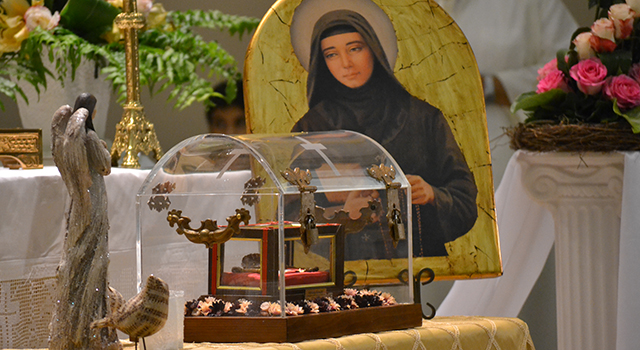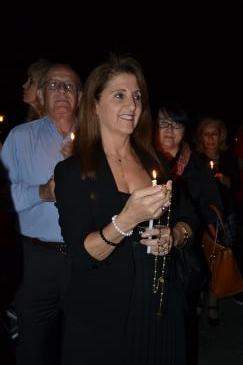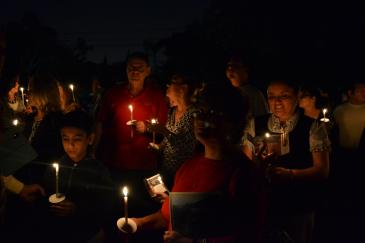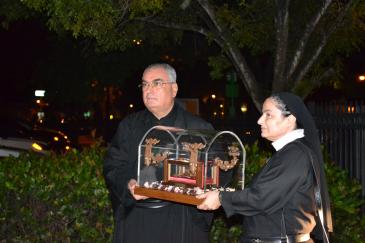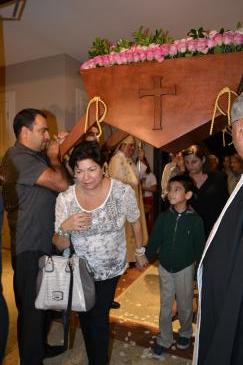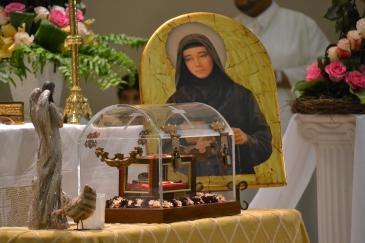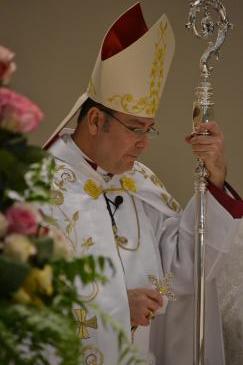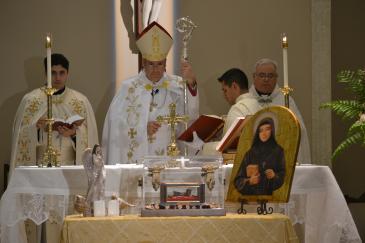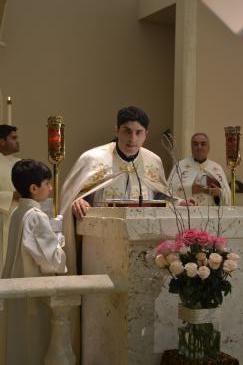By Blanca Morales - Florida Catholic
CORAL GABLES | Amid the twinkling of candlelight, the parish community of Our Lady of Lebanon lifted up songs and rose petals this month to welcome the relics St. Rafqa — a Lebanese nun known as the Little Flower of Lebanon.
Encased in a glass reliquary, the relics, consisting of St. Rafqa’s jaw, shoulder, and hand bones, were ushered in by two sisters from the saint’s religious order, along with their chaplain, Father Paul Azzi. Father Azzi presented the case for the saint’s 1985 beatification in Rome.
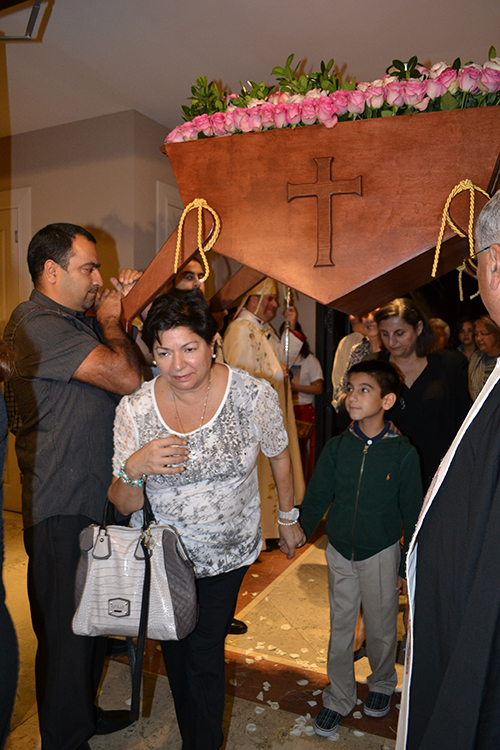
Photographer: MONICA LAUZURIQUE | FC
Parishioners of Our Lady of Lebanon walk under the relics of St. Rafqa upon entering the church.
St. Rafqa was canonized in 2001 by St. John Paul II. This year marks the 100th anniversary of her death. To mark the occasion, her relics have toured just over two dozen cities, visiting the Lebanese diaspora in the U.S.
Miami was the last leg of the relics’ pilgrimage. They arrived at Our Lady of Lebanon Nov. 13 and remained through Nov. 16, for celebrations that included the Divine Liturgy (Mass), rosaries, and a concert.
The idea was for the Lebanese diaspora to feel connected to their roots, as well as to offer hope despite the current disquiet in the Middle East.
“Since they cannot go to Lebanon, St. Rafqa came to them,” said Mother Martha Bassil, superior of the convent of St. Rafqa, who flew to Miami from Lebanon to escort the relics back to Jrabta.
“They saved the best for last,” said Chorbishop Michael Thomas, vicar general and chancellor of the Maronite Eparchy (Diocese) of St. Maron of Brooklyn, as well as founding pastor of Heart of Jesus Maronite Church in Fort Lauderdale and former pastor of Our Lady of Lebanon.
The Maronites are an Eastern Catholic Church in communion with the pope in Rome. Their tradition dates back to Antioch, where Jesus’ followers were first called Christians.
Chorbishop Thomas encouraged those attending the trilingual liturgy — English, Aramaic and Arabic — to follow the example of St. Rafqa, who continually smiled in the midst of suffering. Her uncomplaining nature and self-sacrificing attitude earned her the nickname “the Little Flower of Lebanon.”
Born in 1832, Rafqa (Arabic for “Rebecca”) Al-Rayess chose religious life at the age of 14. She became a teacher and later a contemplative in the Lebanese Maronite Order of St. Anthony. She asked the Lord to share in his suffering, and rejoiced when intense pains lead to blindness and paralysis, leaving only her jaw and hands intact.
She died at the age of 82, after 29 years of suffering. She was buried at St. Joseph Monastery in Jrabta, where her shoulder, hands, and jaw are housed in a reliquary for viewing.
St. Rafqa’s relics first arrived in the U.S. in July for the National Apostolate of Maronites Convention. The bishops of the two U.S. eparchies (Brooklyn and Los Angeles) requested that these first and second-class relics visit their parishes this year.
The veneration of relics allows believers to celebrate the life of the saint and the faith she has inspired in others. The relics, such as the saint’s rosary, evoke her piety and the ways in which she gave her life to Christ. They also remind the faithful that death is not the end of the Christian journey.
Miami was the only city to host the relics for more than one day, and the only place that Mother Bassil visited.
“Our Lady of Lebanon was chosen for the longest visit because it is the oldest and the largest Maronite parish in Florida,” said Nabil Salem, a parishioner and grand knight of the Knights of Columbus’ St. Sharbel Council, the first Eastern Catholic council in Florida.
Our Lady of Lebanon Parish is also among the most diverse Maronite communities in the U.S. Its parishioners are not only Lebanese expats and Lebanese-Americans, but also Lebanese Latinos, and Hispanics of various backgrounds.
The parish celebrates Masses in English, Arabic and Spanish. Hispanic parishioners who live in the neighborhood have learned to pray in Syriac, a dialect of Aramaic used for liturgical prayers. Many parishioners also attend courses in Arabic offered by the parish.
At the welcoming of the relics, a mélange of languages could be heard: English, Arabic, French and Spanish, with everyone borrowing from each other’s native language to communicate — another vivid picture of the multiculturalism of Miami.
William Read, 24, a member of the Maronite young adult group, came dressed in traditional Lebanese costume. He was approached by a group of children who asked, “Are you a pirate?”
Read affirmed that he not only was not a pirate, but he is also not Lebanese. He is of Dominican descent.
“My family has been attending Our Lady of Lebanon for four generations,” he said, as he recounted the history of the parish. “We’ve been here since the first chapel was built in the neighborhood.”
Read headed the procession along with other Maronite young adults, who carried the flags of Lebanon, the ciy of Miami, the U.S., and the Vatican.
Although he admires St. Rafqa, he also confessed to being wary of praying to her. “She might want to share her suffering,” he said.
Father Azzi, however, recounted stories of miraculous healings attributed to the saint’s intercession.
At the end of the liturgy, Father Azzi presented Our Lady of Lebanon’s pastor, Father Elie Saade, with a relic of St. Nimatullah Al-Hardini, a fellow Maronite monk and teacher of another Lebanese saint — the parish’s patron, St. Sharbel.
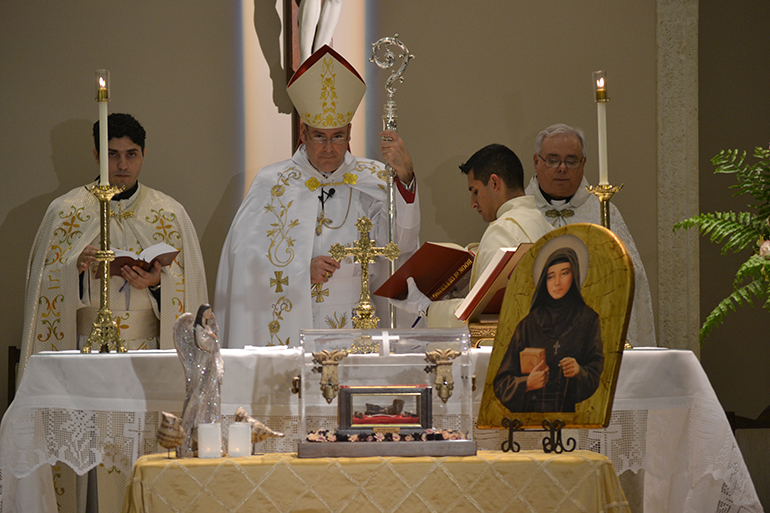
Photographer: MONICA LAUZURIQUE | FC
Chorbishop Michael Thomas, center, vicar general and chancellor of the Maronite Catholic Eparchy of St. Maron of Brooklyn, presides at the Mass with the relics of St. Rafqa. At left is Father Elie Saade, pastor of Our Lady of Lebanon Church.
